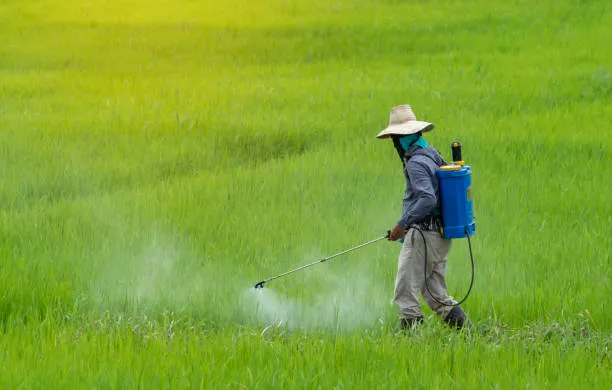Introduction
Monocrotophos 36% SL, commercially known as Monocil, is a highly effective systemic and contact insecticide used in agriculture to control a wide range of pests. It belongs to the organophosphate group of pesticides, known for their potent neurotoxic effects on insects. Monocrotophos is widely used in crops like cotton, rice, sugarcane, and vegetables due to its quick knockdown action and affordability.
However, due to its high toxicity to humans, animals, and beneficial insects, its use is restricted or banned in several countries, including India (as of recent regulations). This blog provides a detailed overview of Monocrotophos 36% SL (Monocil), covering its chemical properties, mode of action, target pests, application methods, safety precautions, and regulatory status.
What is Monocrotophos 36% SL (Monocil)?
Monocrotophos is an organophosphate insecticide and acaricide with systemic and contact action. The 36% SL (Soluble Liquid) formulation is designed for foliar spraying, ensuring rapid absorption and pest control.
Key Features:
- Chemical Class: Organophosphate
- Mode of Action: Acetylcholinesterase (AChE) inhibitor (disrupts nervous system function)
- Formulation: 36% Soluble Liquid (SL)
- Target Pests: Sucking, chewing, and boring insects
- Crop Compatibility: Cotton, rice, sugarcane, maize, soybeans, vegetables
- Toxicity Level: Highly toxic (WHO Class Ia – Extremely Hazardous)
Mode of Action
Monocrotophos works by inhibiting acetylcholinesterase (AChE), an enzyme essential for nerve signal transmission in insects. This leads to:
- Overstimulation of nerves
- Convulsions, paralysis, and death of the pest
Since it has both systemic and contact action, it is absorbed by plant tissues and also kills pests on direct contact.
Benefits of Monocrotophos 36% SL (Monocil)
- Fast-Acting: Provides quick knockdown of pests.
- Broad-Spectrum Control: Effective against multiple pest types (sucking, chewing, and boring insects).
- Affordable: Cost-effective compared to newer insecticides.
- Systemic Action: Protects plants from within, reducing re-infestation.
- Rainfastness: Remains effective even after light rain.
Target Pests
Monocrotophos is highly effective against:
- Aphids (Aphis gossypii)
- Jassids/Leafhoppers (Amrasca biguttula)
- Whiteflies (Bemisia tabaci)
- Bollworms (Helicoverpa armigera)
- Stem Borers (Chilo partellus)
- Thrips (Thrips tabaci)
- Mites (Tetranychus spp.)
Application Methods
Monocrotophos 36% SL is primarily used as a foliar spray.
1. Recommended Dosage & Spraying Procedure
- Dilution: Mix 1.5–2 mL per liter of water (varies based on crop and pest intensity).
- Spray Volume: 300–500 liters per hectare.
- Application Timing: Early morning or late evening to avoid bee activity.
- Reapplication: Repeat after 10–15 days if pest pressure persists.
2. Crop-Specific Dosage Guidelines
| Crop | Target Pest | Dosage (mL per liter of water) |
| Cotton | Bollworms, Aphids | 1.5 – 2 mL/L |
| Rice | Stem Borer, Leafhoppers | 1.5 – 2 mL/L |
| Sugarcane | Early Shoot Borer | 2 mL/L |
| Vegetables | Fruit Borers, Aphids | 1 – 1.5 mL/L |
Safety Precautions & Handling
Due to its extreme toxicity, Monocrotophos must be handled with strict safety measures.
1. Personal Protective Equipment (PPE)
- Gloves, mask, goggles, and full-body coverings must be worn.
- Avoid inhalation or skin contact – can cause poisoning.
2. Environmental & Non-Target Safety
- Highly toxic to bees, birds, and aquatic life – avoid spraying near water bodies or flowering crops.
- Do not use near residential areas – risk of inhalation exposure.
3. First Aid Measures
- If inhaled: Move to fresh air immediately.
- If swallowed: Do NOT induce vomiting; seek medical help.
- Skin contact: Wash with soap and water.
4. Storage & Disposal
- Store in a locked, ventilated area away from food and feed.
- Dispose of empty containers by puncturing and burying in designated pits.
Dealer:https://www.bighaat.com/products/agriventure-monophos
Regulatory Status & Ban in India
Due to its high toxicity, Monocrotophos has been banned or restricted in many countries:
- India: Banned since 2020 (except for locust control under government supervision).
- European Union: Banned since 2006.
- USA: Never registered due to extreme hazards.
Why Was It Banned?
- Human Poisoning Cases: Linked to farmer suicides and accidental deaths.
- Environmental Harm: Kills beneficial insects (bees, earthworms) and birds.
- Residue Concerns: Persists in food crops, posing health risks.
Alternatives to Monocrotophos
Safer alternatives include:
- Neonicotinoids (Imidacloprid, Thiamethoxam) – Less toxic to mammals.
- Biopesticides (Azadirachtin, Spinosad) – Eco-friendly options.
- IGRs (Insect Growth Regulators) – Target-specific, low toxicity.
Conclusion
Monocrotophos 36% SL (Monocil) was once a popular insecticide due to its broad-spectrum efficacy and low cost, but its extreme toxicity led to bans in many countries, including India. While it provides quick pest control, the risks to human health, wildlife, and the environment outweigh its benefits.
Farmers should switch to safer alternatives and follow Integrated Pest Management (IPM) practices to ensure sustainable agriculture.
Final Thoughts
The ban on Monocrotophos highlights the importance of responsible pesticide use. By adopting eco-friendly pest control methods, farmers can protect their crops without harming themselves or the ecosystem.
Always follow government guidelines and use approved pesticides only.
Disclaimer: This blog is for informational purposes only. Always consult agricultural experts before using any pesticide.
Sourashis Chanda brings readers their unique perspective on Business, Economy, Health and Fitness. With a background in Health and Physical Fitness of 2years, I am dedicated to exploring [what they aim to achieve with their writing, on the sustainable Economy of the country, various pro tips about business, latest goverment news, with some tips in health are and Fitness.







